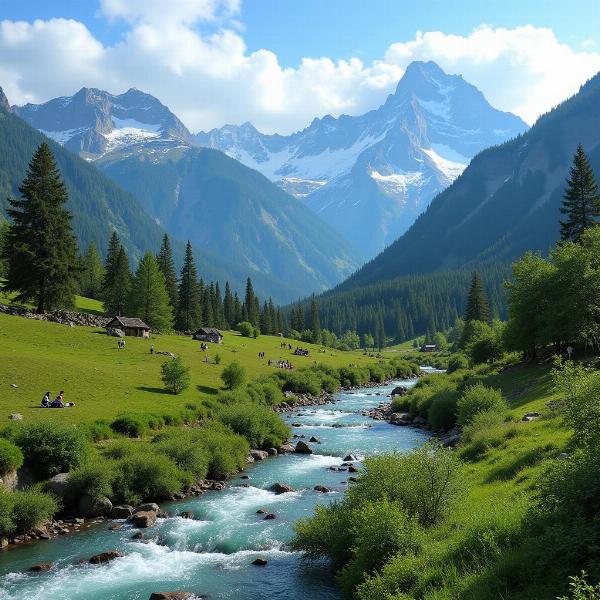Understanding the meaning of “reserve nature” in Hindi requires delving into the nuances of both English and Hindi ecological terminology. While a direct, single-word translation might not perfectly capture the essence, the concept of protected natural areas resonates deeply within Indian culture and language. This article explores various Hindi translations and their cultural context, providing a comprehensive understanding of “reserve nature” and its significance in India.
Exploring Hindi Translations for “Reserve Nature”
Several Hindi phrases effectively convey the meaning of “reserve nature.” The most common and accurate translation is “प्राकृतिक आरक्षित क्षेत्र” (prakritik aarक्षित kshetra), which literally translates to “natural reserved area.” This term accurately reflects the concept of a designated area set aside for the conservation of nature.
Other suitable translations include “वन्यजीव अभयारण्य” (vanyajeev abhyaranya), meaning “wildlife sanctuary,” and “राष्ट्रीय उद्यान” (rashtriya udyan), meaning “national park.” While these terms might not encompass all aspects of “reserve nature,” they represent specific types of reserved natural areas. Choosing the most appropriate translation depends on the specific context. For example, if discussing a protected area primarily for wildlife, “vanyajeev abhyaranya” would be ideal.
Understanding the Cultural Context of Nature Conservation in India
India’s rich cultural heritage places significant emphasis on the reverence for nature. Ancient scriptures and traditions highlight the interconnectedness of humans and the natural world. This deep-rooted respect for nature has shaped conservation efforts and contributed to the establishment of numerous protected areas across the country.
The concept of “ahimsa,” or non-violence, extends beyond human interactions to encompass all living beings and the environment. This philosophy fosters a sense of responsibility towards protecting and preserving nature. Numerous religious and spiritual practices in India involve worshipping natural elements, further reinforcing the importance of environmental stewardship.
Delving into Specific Types of Reserved Areas in India
India boasts a diverse range of protected areas, each serving a specific conservation purpose. National parks, wildlife sanctuaries, and biosphere reserves are among the most prominent categories. Understanding the differences between these designations is crucial for grasping the broader meaning of “reserve nature” within the Indian context.
National Parks: Protecting Biodiversity Hotspots
National parks are designated areas primarily focused on the protection of entire ecosystems, including flora, fauna, and geological features. These areas often represent biodiversity hotspots and play a vital role in conserving endangered species.
Wildlife Sanctuaries: Safe Havens for Wildlife
Wildlife sanctuaries prioritize the protection of specific animal species, offering them safe havens from hunting and habitat destruction. These areas often focus on conserving vulnerable or endangered species, allowing their populations to recover and thrive.
Biosphere Reserves: Integrating Conservation and Sustainable Development
Biosphere reserves represent a unique approach to conservation, integrating the protection of biodiversity with sustainable development. These areas aim to balance human activities with ecological preservation, promoting harmonious coexistence between communities and nature.
What are the benefits of Reserve Nature?
Reserving natural spaces has numerous benefits, including protecting biodiversity, maintaining ecological balance, providing research opportunities, and boosting tourism. These reserved areas become havens for various plant and animal species, contributing to the overall health of the ecosystem. They also serve as living laboratories for scientific research and offer educational opportunities for the public. Furthermore, the scenic beauty and unique wildlife of these areas attract tourists, generating revenue and supporting local communities.
 National Park in India
National Park in India
Conclusion
“Reserve nature” in Hindi encompasses a range of protected areas, reflecting India’s deep-rooted cultural respect for the natural world. Understanding the various Hindi translations and the different types of reserved areas provides a comprehensive insight into the importance of nature conservation in India. Protecting these natural treasures is crucial for maintaining ecological balance, preserving biodiversity, and ensuring a sustainable future.
FAQ
- What is the most common Hindi translation for “reserve nature”? The most common translation is “प्राकृतिक आरक्षित क्षेत्र” (prakritik aarक्षित kshetra).
- What is the significance of “ahimsa” in nature conservation? Ahimsa promotes non-violence towards all living beings and the environment, fostering a sense of responsibility for nature’s protection.
- What is the primary focus of a wildlife sanctuary? Wildlife sanctuaries primarily focus on protecting specific animal species, providing them with safe havens.
- How do biosphere reserves differ from national parks? Biosphere reserves integrate conservation with sustainable development, aiming for a balance between human activities and ecological preservation.
- Why is reserving nature important? Reserving nature protects biodiversity, maintains ecological balance, provides research opportunities, and boosts tourism.
Related Articles
- meaning of quills in hindi
- exhaustible and inexhaustible meaning in hindi
- cutie in hindi meaning
- freshwater meaning in hindi
Meaning-Hindi.in is a leading provider of professional Hindi translation services, catering to diverse needs, from business and legal documents to technical manuals and website localization. Our expertise extends to educational and academic materials, ensuring accurate and culturally sensitive translations. We also offer express translation services for urgent requirements. For all your Hindi translation needs, contact us at [email protected] or call us at +91 11-4502-7584. Meaning-Hindi.in is your trusted partner for bridging the language gap.